Ventilation basement: a device on its own using available
In this article we will talk about how to mount the basement ventilation with your own hands. In addition, we consider the benefits of using efficient ventilation in the basement.
The topic of the article is of considerable interest, since most of the country houses and country houses are equipped with a basement room used for long-term storage of supplies and crops harvested on the household plot.
How well these supplies will last for a given time depends largely on the parameters of the microclimate. We also note that the microclimate parameters are determined by the performance of the ventilation system used in the construction of the basement.
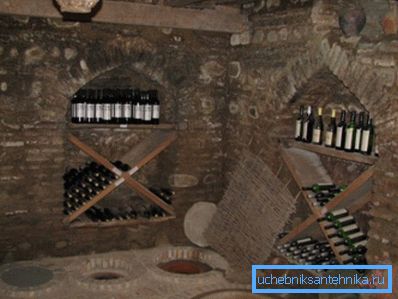
The need for a ventilation device in the basement

Until recently, basement ventilation rates were not taken into account when designing a house. The only requirement that was imposed on such premises was good thermal insulation, which allowed to maintain optimal temperature parameters for a long time. That is why, the basement doors were carefully insulated and sealed, then, few people thought about ventilation.
In fact, the lack of air exchange leads to an increased moisture content and, consequently, to dampness in the room. Hence the smell of funeral mustiness and mold.
Excess moisture content, in combination with standing air and a temperature in the region of + 5 ° C, are optimal conditions for the activity of pathogens. In addition, dampness adversely affects the safety of the construction object, as in conditions of high moisture content in the air, the plaster finish, as well as the walls and floors, are gradually destroyed.
So, in order to ensure optimal storage conditions for supplies in the basement, in order to prevent mold and other fungal infections and, finally, in order to prevent the gradual destruction of the construction site, good ventilation is necessary.
Consider how to properly make the ventilation in the basement using simple instructions and using the available materials.
Types of ventilation
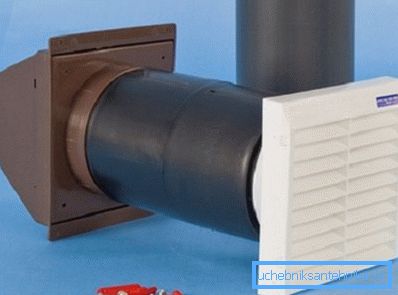
Before we do the ventilation in the basement, we will determine the most relevant to date schemes.
All air exchange systems used today can be divided into two types:
- natural type - works due to the difference in pressure and air temperature;
- forced type - works by using bladed fans, the price of which depends on the performance.
Both types, with proper organization, have characteristic advantages. However, there are some drawbacks that will have to be taken into account.
Natural ventilation in the basement
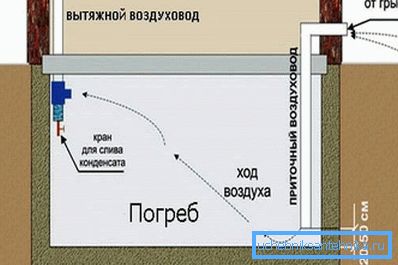
Natural ventilation in the basement works due to the difference in air pressure inside and outside the building. Thus, in order for the system to fully function, it is enough to have a supply and exhaust hole located at different levels.
Through the fresh air inlet, cold fresh air will flow into the basement from the outside, while through the exhaust nozzle, moist heated air will flow out.
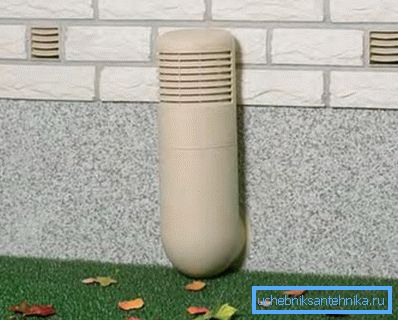
Do you think it is difficult to implement such a scheme without the help of experts?
Nothing of the kind, the instruction is simple and involves the following work:
- At the stage of laying the foundation and plinth install the inlet pipe. The opening of the inlet pipe inside the basement should be located at a height of half a meter from the floor level. The outer end of the pipe must also rise above the ground level by no more than half a meter.
Important: The optimal diameter of the pipe for the device ventilation channels is 100 mm. With increasing or decreasing diameter thrust will weaken.
- At the same time, when we equip a supply air duct, we make a chimney.
The hole in the basement is located as close as possible to the ceiling from the side of the inlet duct. The outer end of the exhaust pipe is installed so that it is about half a meter above the ridge of the roof of the house.
Important: When designing the ventilation, we try to arrange everything so that the exhaust air duct is located on the north side, and the supply air side is on the south side. If this requirement is met, the system will work effectively in all weather conditions.
- In the next stage, the holes in the tubes are covered with a fine-meshed net, which will prevent the entry of insects and rodents into the interior.
- At the final stage, we check how effectively the system works.. To do this, go down to the cellar and bring a lit candle to the exhaust vent. The flame should deviate from the initial position by about 45 degrees.
If the flame deviates by 90 degrees, or goes out altogether, then the thrust is excessive and must be relaxed. For this, the outer part of the exhaust duct is gradually shortened by 25 cm lengths and immediately check the draft.
If the exhaust pipe is still excessive, the room during the cold season will be thinned out.
When deciding to equip your cellar or basement with natural ventilation, it is necessary to take into account that the effectiveness of such systems depends on a number of factors, including weather conditions and the temperature of the external environment.
Important: The warmer outside, the less thrust and the lower the intensity of air exchange. The use of forced-type ventilation will make the indoor climate more predictable.
Forced ventilation
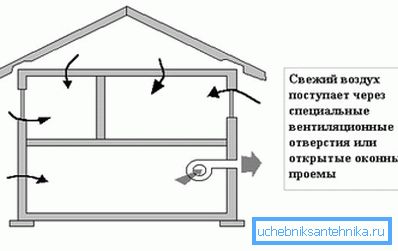
The instruction of the forced-type ventilation device differs radically from the recommendations for the manufacture of natural action systems.
Forced ventilation is arranged at the stage of building a house. Therefore, it is advisable to plan such systems not for the cellar and other ancillary facilities separately, but for the whole house as a whole. Systems of forced type - supply and exhaust, in the end, how much air is discharged outside, as much outside enters.
A characteristic difference of the forced circuit from the analogs of the natural type is the presence of a bladed fan, which directs air into the duct. Due to the use of a fan, the system is characterized by greater efficiency than in the case of a modification that operates according to the natural principle.
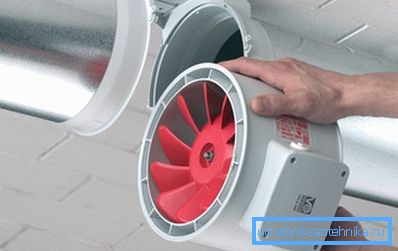
Among the recommendations on the device of the forced systems we will answer the following:
- The air duct openings cannot be peeled off at the same level, as it will result in a draft.
- It is not necessary to distribute the inlet and exhaust connections on different sides of the room, since they can be arranged on one wall.
- It is imperative to take care of the condensate drain.
- The fan is installed in the part of the duct in which the smallest probability of formation and accumulation of condensate.
- As in the case of natural air ducts, we must use fine-meshed nets, which will trap insects and rodents.
Conclusion
Now that we know how to arrange ventilation in the basement with our own hands, it’s time to get the necessary materials and apply the skills we learned in practice.
There are questions that need clarification? More useful information can be found by watching the video in this article.